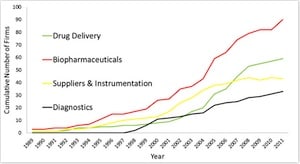
We’ve suggested that biotechnology could serve as an enabling technology for the development of atomically precise manufacturing (through an opensource biological parts depository for building molecular machines and through a ground-breaking innovation to have robots do biotech experiments “in the cloud”). Whether or not the confluence of biotechnology and nanotech advances the development of atomically precise manufacturing, this confluence has already opened a path to new products and new markets. An article over at KurzweilAI reports two studies on opportunities in the emerging nanobiotechnology industry “Innovation management and the emergence of the nanobiotechnology industry“:
The confluence of nanotechnology and biotechnology is creating opportunities and an emerging industry, nanobiotechnology, with tremendous potential for economic and social value creation, according to an international research team at MIT, Simon Fraser University, and the University of New South Wales
The medical applications of nanobiotechnology are promising, including effectively targeted drug delivery — imagine highly efficacious cancer treatment with few side effects — and real time, minimally invasive diagnostics. But there is little known about the emergence of this industry or of ways to reap the possible benefits. …
Innovation, and the growth of new industries, is thought to be more likely when a firm occupies the confluence or convergence of distinct streams of emerging technology. Research progress at the intersection of fields is probably more likely to occur when cross-disciplinary new product development teams are designed by the organization and when routines and processes are designed to support cross-disciplinary learning. A confluence of technologies is characterized both by the bringing together of formerly disparate fields of knowledge, and by the creation of new product markets. When a confluence of technology streams occurs, rich opportunities for experiment and progress may result, suggests Professor James Utterback of MIT.
Strategies that one might suggest as particularly useful for enabling innovation would include importing ideas from broad networks and diverse sources, hiring persons from diverse backgrounds, and creating an environment conducive to deep collaboration. This would include co-location of diverse groups, creating a culture and which encourages vigorous debate and differences in perspective.
The Foresight Institute was perhaps the first organization to perceive the different technological threads that would weave the fabric of nanotechnology, and the value of bringing them together in the hope of seeding collaborations. Starting in 1989, Foresight Conferences on nanotechnology have brought together experts in fields as diverse as biotechnology, surface physics, chemistry, materials science, and computation to encourage cross-fertilization and collaborations, shaping nanotechnology as it exists today, and in the hope of paving the way to productive nanosystems and atomically precise manufacturing tomorrow.
—James Lewis, PhD
